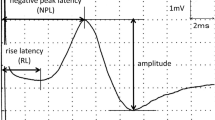Abstract
Objective
Multiple electrophysiologic studies have been conducted in the evaluation of facial neuropathy. In our study, the diagnostic and prognostic values of nerve conduction studies (NCSs) and transcranial magnetic stimulation (TMS) were compared for idiopathic unilateral facial neuropathy.
Method
We recruited patients with newly diagnosed idiopathic unilateral facial neuropathy and performed a blink reflex test, facial NCSs, and TMS. The amplitude of facial compound muscle action potential (CMAP) and motor evoked potential (MEP) between the affected and unaffected sides of the face was compared.
Result
A total of 30 patients were enrolled in the final analysis. TMS yielded a better detection rate, and MEP reduction rate was significantly higher than CMAP reduction rate, early in the course of the disease. Poor prognosis was positively associated with the CMAP reduction rate. The cutoff value of the CMAP reduction rate in the prediction of poor prognosis was established as 0.42.
Conclusion
Facial TMS could detect idiopathic unilateral facial neuropathy with a high sensitivity when used as an early diagnostic tool. Facial NCS could predict prognosis, and the CMAP reduction rate was significantly associated with poor short-term prognosis.




Similar content being viewed by others
Data Availability
The datasets generated during the current study are available from the corresponding author on reasonable request.
References
Morgan M, Nathwani D (1992) Facial palsy and infection: the unfolding story. Clin Infect Dis 14:263–271. https://doi.org/10.1093/clinids/14.1.263
Peitersen E (2002) Bell's palsy: the spontaneous course of 2,500 peripheral facial nerve palsies of different etiologies. Acta Otolaryngol Suppl 549:4–30 https://pubmed.ncbi.nlm.nih.gov/12482166/
Ghonim MR, Gavilan C (1990) Blink reflex: prognostic value in acute peripheral facial palsy. ORL 52(2):75–79. https://doi.org/10.1159/000276109
Schriefer TN, Mills KR, Murray NM, Hess CW (1988) Evaluation of proximal facial nerve conduction by transcranial magnetic stimulation. J Neurol Neurosurg Psychiatry 51(1):60–66. https://doi.org/10.1136/jnnp.51.1.60
House JW, Brackmann DE (1985) Facial nerve grading system. Otolaryngol Head Neck Surg 93(2):146–147. https://doi.org/10.1177/019459988509300202
Kimura J, Giron LT, Young SM (1976) Electrophysiological study of bell palsy: electrically elicited blink reflex in assessment of prognosis. Arch Otolaryngol 102(3):140–143. https://doi.org/10.1001/archotol.1976.00780080062005
Rösler KM, Hess CW, Schmid UD (1989) Investigation of facial motor pathways by electrical and magnetic stimulation: sites and mechanisms of excitation. J Neurol Neurochir Psychiatr 52(10):1149–1156. https://doi.org/10.1136/jnnp.52.10.1149
Glocker FX, Magistris MR, Rösler KM, Hess CW (1994) Magnetic transcranial and electrical stylomastoidal stimulation of the facial motor pathways in Bell’s palsy: time course and relevance of electrophysiological parameters. Electroencephalogr Clin Neurophysiol 93(2):113–120. https://doi.org/10.1016/0168-5597(94)90074-4
Happe S, Bunten S (2012) Electrical and transcranial magnetic stimulation of the facial nerve: diagnostic relevance in acute isolated facial nerve palsy. Eur Neurol 68(5):304–309. https://doi.org/10.1159/000341624
Nowak D, Linder S, Topka H (2005) Diagnostic relevance of transcranial magnetic and electric stimulation of the facial nerve in the management of facial palsy. Clin Neurophysiol 116:2051–2057. https://doi.org/10.1016/j.clinph.2005.05.007
Prakash KM, Raymond AA (2003) The use of nerve conduction studies in determining the short term outcome of Bell’s palsy. Med J Malaysia 58(1):69–78 https://pubmed.ncbi.nlm.nih.gov/14556328/
Volk GF, Klingner C, Finkensieper M, Witte OW, Guntinas-Lichius O (2013) Prognostication of recovery time after acute peripheral facial palsy: a prospective cohort study. BMJ Open 3:e003007. https://doi.org/10.1136/bmjopen-2013-003007
Jackson CG, Johnson GD, Hyams VJ, Poe DS (1990) Pathologic findings in the labyrinthine segment of the facial nerve in a case of facial paralysis. Ann Otol Rhinol Laryngol 99(5 Pt 1):327–329. https://doi.org/10.1177/000348949009900501
Balkany T, Fradis M, Jafek BW, Rucker NC (1991) Intrinsic vasculature of the labyrinthine segment of the facial nerve-implications for site of lesion in Bell’s palsy. Otolaryngol Head Neck Surg 104(1):20–23. https://doi.org/10.1177/019459989110400105
Acknowledgements
The authors thank all of the study participants. We also appreciated that this manuscript was edited by Wallace Academic Editing.
Code availability
Not applicable
Funding
This work was supported by grants from E-DA hospital research project (EDAHC108005).
Author information
Authors and Affiliations
Contributions
Dr. Lin was the chief investigator of the study. Dr. Chen was responsible for the data extraction and statistical analysis. Dr. Tsai and Dr. Hsu contributed to patient recruitment and article writing, and Dr. Hsu was the tutor of the research project. All authors reviewed the draft and contributed to the final version
Corresponding author
Ethics declarations
Ethics approval and consent to participate
This study conformed to the guidelines of the Declaration of Helsinki and received approval from the Institutional Review Board of E-DA Hospital (EMRP40107N). Informed consent was obtained from all individual participants included in the study.
Competing interests
The authors declare that they have no competing interests.
Additional information
Publisher’s note
Springer Nature remains neutral with regard to jurisdictional claims in published maps and institutional affiliations.
Rights and permissions
About this article
Cite this article
Lin, HJ., Chen, PC., Tsai, TT. et al. Comparison of nerve conduction study and transcranial magnetic stimulation for early diagnosis and prognosis prediction of idiopathic facial palsy. Neurol Sci 42, 4149–4154 (2021). https://doi.org/10.1007/s10072-021-05095-4
Received:
Accepted:
Published:
Issue Date:
DOI: https://doi.org/10.1007/s10072-021-05095-4




